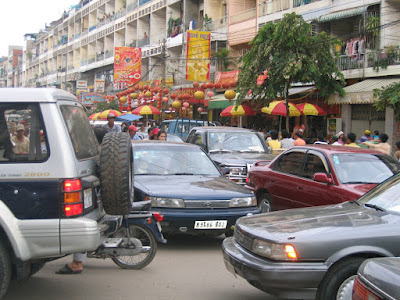Traffic congestion has been one of the obvious and significant problems in Phnom Penh. Besides public stress on the road due to the traffic jams, traffic congestion impacts negatively on the environment and the economy. How much money have people burned uselessly through the gasoline consumption while sitting in a traffic jam? How much time have people wasted as a result of traffic congestion? The reality is that this happens every day, especially from 6 am to 8 am, and 4 pm to 7 pm. Needless to say, resolving this issue has the potential to make Phnom Penh a better city economically and environmentally. In order to come up with solutions we first need to understand why traffic congestion has become such an issue. This begs the question: “Is the traffic congestion in Phnom Penh mainly the result of urban development?”
Urban development, by its nature brings more people into a city. Phnom Penh is the capital city of Cambodia, and it is the heart of various forms of development including infrastructure, services, and health care. For the last decade there has been a trend which has seen people in rural areas moving to find jobs and build new lives in the city. In 2011 it was estimated that 100,000 residents had migrated to Phnom Penh, increasing its population to approximately 2 million people. At the same time, according to the Cambodia’s Transportation Ministry’s report released in the same year, there was an estimated 800,000 motorbikes and 170,000 vehicles in Phnom Penh. These numbers are anticipated to continue to increase every day.
Two of the common causes of the traffic jams anywhere are small roads and too many vehicles. While these increases in population and vehicle usage have been happening, the numbers of roads and their sizes in Phnom Penh have remained more or less the same. This seems to suggest a clear link between urbanization and traffic congestion: more people with more vehicles and limited expansion of the road network. However, according to some people in Phnom Penh we have interviewed, the key causes of traffic congestion are beyond the urban development.
When asked what he thought of as the main causes of traffic congestion in the city, Sopheap, who is a student at Royal University of Fine Arts, said that urban development is unquestionably one of the reasons to cause traffic jams. Nonetheless, to him the issue that first needs to be dealt with is that of people disobeying the traffic laws. He added, “Many of the time, it is not the small roads that is the problem but how people drive, and even a motorbike could cause the whole traffic jam if the traffic laws are not obeyed.”
Sok Hout, a student in SETECH Institute, he pointed out another common cause of traffic jams. He said that traffic jams happen more frequently in rainy season because when there is heavy rain many roads would get flooded, causing un-flooded roads to be even busier. As a result, people get stuck on the roads for hours. You can imagine what a significant issue this is given that rainy season lasts six months a year.
These students have highlighted real issues in Phnom Penh experienced by all of its residents, in addition to the problems that arise from urbanization. As such, all of these issues need to be addressed in order to reduce traffic congestion. So far, we have efforts from the government to reconstruct some roads as well as build the Skybridges, such as the 7 Makara Skybridge, to ease the problem of traffic congestion in the city. Nevertheless, the traffic law enforcement and the sewage system are still seen to have limited improvement even though they are key factors to making traffic in Phnom Penh a lot better and less busy.
Source: Urban Voice





EmoticonEmoticon